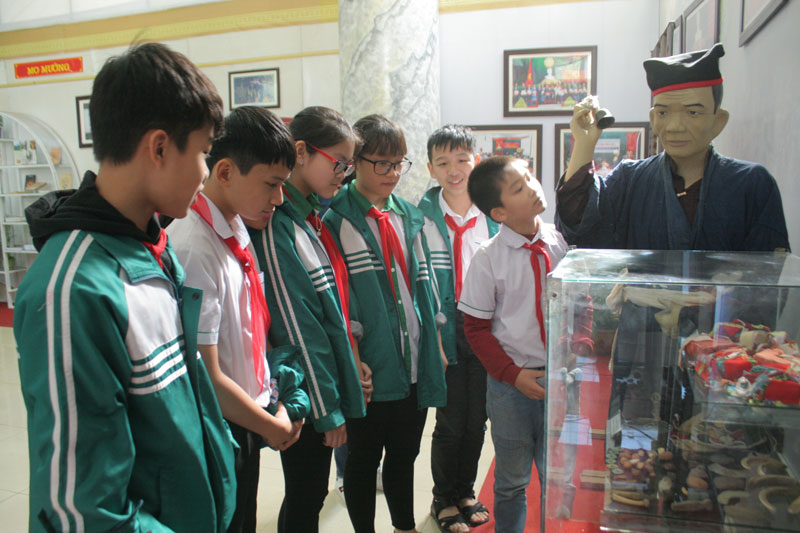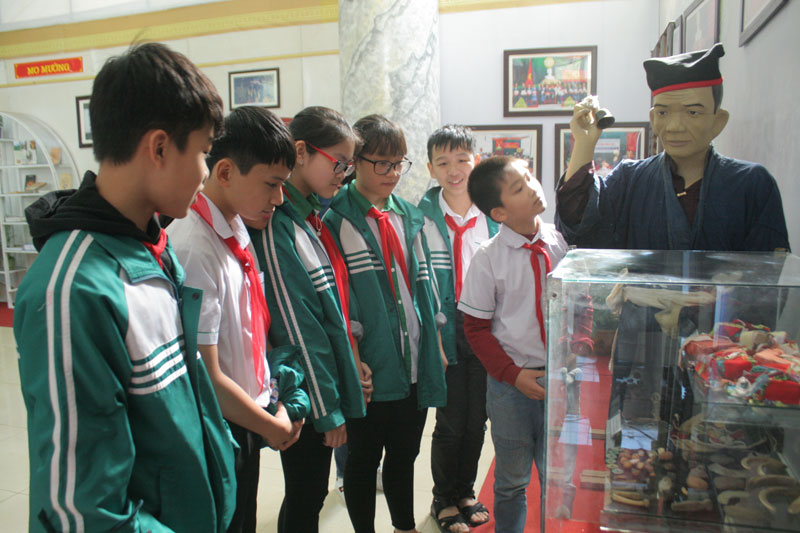
(HBO) - The Hoa Binh Department of Culture, Sports and Tourism opened a new display hall, themed "Typical cultural heritages of the Muong ethnic minority group in Hoa Binh" at the provincial museum to mark the Vietnam Heritage Day (November 23). The opening ceremony on November 23 was attended by Nguyen Van Chuong, Vice Chairman of the provincial People's Committee, leaders of provincial departments and agencies, as well as more than 100 teachers and students of the Ly Tu Trong Junior High School.

Delegates and students visit the display hall.
The opening speech of a
top official of the provincial Department of Culture, Sports and Tourism highlighted
the rich and diverse cultural heritage of Hoa Binh, which serves as a resource
for socio-economic development in the cause of reform and international
integration.
The official said the
Muong ethnic cultural heritage has left deep imprints on many aspects of local
society, including stilt houses, costumes, cuisine, historical relics,
antiques, customs, festivals, religions and beliefs, language, music, and
performing arts. The Muong people are proud to be the cradle of the famous Hoa
Binh cuture.
On display at the hall are
nearly 200 documents and original artifacts, such as bronze drums, gongs, and
ancient pottery found in Muong tombs. Especially, for the first time, visitors had
a chance to explore the special value of the Mo Muong, which is recognised as an
item in the national intangible cultural heritage.
The display is meant to be
a step to implement the Party's Resolution on developing an advanced Vietnamese
culture imbued with national characteristics, while honoring and promoting the
Muong ethnic culture in the Vietnamese community of ethnic groups, and
educating the public, especially younger generations, on cultural traditions.
With an increasingly vibrant and widespread emulation movement aimed at building cultured residential areas and cultured families, Yen Thuy District has been making steady progress toward improving both the material and spiritual well-being of its people, while fostering a civilized, prosperous, beautiful, and progressive community.
Once lacking recreational spaces and community facilities, Residential Group 2 in Quynh Lam Ward (Hoa Binh City) has recently received attention for the construction of a new, spacious, and fully equipped cultural house. The project followed the model of state support combined with public contributions in both labor and funding.
The "All people unite to build cultural life" movement, which has been effectively integrated with Kim Boi district’s socio-economic development goals, is fostering a lively spirit of emulation across local residential areas, hamlets, villages, public agencies, and enterprises. In addition, through the initiative, traditional cultural values are being preserved and promoted, while community solidarity and mutual support in poverty reduction and economic development are being strengthened.
A working delegation of the Hoa Binh provincial People’s Committee led by its Permanent Vice Chairman Nguyen Van Toan on June 11 inspected the progress of a project to build the Mo Muong Cultural Heritage Conservation Space linked to tourism services in Hop Phong commune, Cao Phong district.
Born and growing in the heroic land of Muong Dong, Dinh Thi Kieu Dung, a resident in Bo town of Kim Boi district, in her childhood was nurtured by the sweet lullabies of her grandmother and mother. These melodies deeply imprinted on her soul, becoming an inseparable part of her love for her ethnic group's culture. For over 20 years, this love for her hometown has driven Dung to research, collect, and pass down the cultural values of the Muong people to future generations.
In the final days of May, the Ethnic Art Troupe of Hoa Binh Province organized performances to serve the people in remote, mountainous, and particularly disadvantaged areas within the province. These were not just ordinary artistic shows, but they were the meaningful journeys aimed at spreading cultural values, enhancing the spiritual life of the people and contributing to the preservation of ethnic minority cultural identities.



